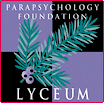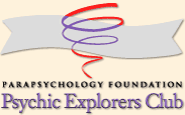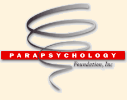 |
 |
| Alejandro Parra  Who has not asked himself why he decided to get into parapsychology? Perhaps unlike others, in my own case I was not drawn in through personal experiences or particular paranormal phenomena. Who has not asked himself why he decided to get into parapsychology? Perhaps unlike others, in my own case I was not drawn in through personal experiences or particular paranormal phenomena.
I have always had a rational attitude about these phenomena and thought that we need to create knowledge independently of how little or how much we know about other aspects of reality. In my view creativity is a vital part of scientific activity. I was always moved by the words of Gene Roddenberry, the creator of Star Trek, the popular TV series of the 1960s: “To explore new worlds, to go where no man has gone before.” Can we really be original in the creation of new knowledge? I think this is an important question in parapsychology, particularly in the research necessary to develop a model that can predict psi. As J. Gaither Pratt said, we are still waiting for the Albert Einstein of parapsychology. Although I work as a psychotherapist and I have been the editor of the Revista Argentina de Psicología Paranormal for 15 years (1990–2005), the 1980s was not a good time to get into parapsychology as a science. While Argentina was going through a critical social and economic situation in those years, interest in parapsychology grew. In this context I became involved in parapsychology. During the 1980s, as an adolescent, I began to read all kinds of popular magazines and books. I remember that, with a friend, we decided to play the “cup game.” We held a séance using a glass cup as a communication device. The cup sat on a table illuminated by a candle. During the game I heard many accounts of phenomena that seemed to require a Spiritist interpretation. Full of enthusiasm, my friend and I saw the glass move over the table, a distance of at least 30 centimeters without anyone touching it. Full of wonder and doubt, I could not explain what I saw. But this increased my interest in parapsychology. I had no problem finding books on the topic, but it was hard to find people who, like myself, were interested in explaining these phenomena. During the mid 1980s, I met parapsychologist Leonardo Sternberg, who was the director of the Centro de Orientación Parapsicológica (Center of Parapsychological Orientation). He said he had such psychic abilities as the power to make paper combust and metal to bend psychokinetically and that he could use his ESP to help people. Sternberg became very popular, although he worked more as a psychic than as a parapsychologist. During those years he gave radio programs, and even organized some parapsychology conferences. I disagreed with some of his speculations, but I liked him because he always advised people to maintain a critical attitude. Whether for good or ill, Sternberg was a deciding factor in my vocation for parapsychology. About the same time I became involved with the Laboratorio Argentino de Psicotrónica Aplicada (Argentinean Laboratory of Applied Psychotronics), where I took a parapsychology course. The Laboratory had an educational approach and offered popular courses. I prepared a space to do studies and conducted some exploratory work such as ESP experiments using the ganzfeld technique. I met Naum Kreiman and Father Enrique Novillo Paulí, the only two parapsychologists who were following the approach I was interested in. These contacts allowed me to get into the experimental dimension of parapsychology. In 1989, Jorge Villanueva and I decided to edit the first issue of the Revista Argentina de Psicología Paranormal. We obtained articles from such figures as Gertrude R. Schmeidler, Stanley Krippner, Robert L. Morris, and Carlos S. Alvarado. Their support fueled our initiatives. Slowly we collected books and created the most important parapsychology library in Argentina today. Our library now has over 2500 books, 7000 periodicals, and thousands of hours of videos and DVDs. We always kept our distance from those who looked to RAPP for surprising and revolutionary parapsychological findings, proof of government conspiracies, incredible mystical or spiritual revelations, or contact with UFOs or the like. We published the best offering of Argentinean and Ibero-American parapsychology. However, the journal was discontinued because of financial reasons. I do not see its closing as a loss, but as an interruption. Starting in 2006, we will inaugurate a new on-line publication. In 1994, we created the Instituto de Psicología Paranormal (IPP, Institute of Paranormal Psychology) and in 2004, it was legally incorporated. Currently, the IPP has ten active members, most of them psychologists. Since 1996 the IPP has had a website with information about parapsychology in Spanish. The IPP has hosted several congresses bringing together researchers from Argentina, Brazil, Chile, México, Spain and the USA. I have conducted experimental research and have authored publications intended to popularize scientific parapsychology, among these are several articles I have written for such magazines as Año Cero (Spain) and Sexto Sentido (Brazil). My colleagues and I have obtained several grants from the Fundação Bial in Portugal between the years of 1998 and 2004. These grants have allowed us to conduct studies of: ESP in the ganzfeld; psychometry; psychomantheum; and the psychological study of spontaneous experiences. I have also written a book about the history of Argentinean parapsychology, an introductory text in parapsychology, and a book on dreams. I am currently involved in a questionnaire study of hallucinations in a non-clinical population that includes an item about veridical experiences. One of the main problems I have found is the context in which parapsychology has developed in Argentina. Although my country has a variety of psychological theories and therapies, there have been relatively few publications in psychology. The same is true in parapsychology. Parapsychology is not included in the education of psychologists and there are few philantropists to help the field. Furthermore, we lack a strong parapsychological movement that centers on and encourages scientific work in the field in Argentina. In summary, I have been active in parapsychology in six areas: counseling, popularization, education, research, social concerns, and publications. I hope that this brief biography is helpful to students and others who are interested in joining our quest. Gómez Montanelli, D. E. & Parra, A. (in press). Are spontaneous anomalous/paranormal experiences disturbing? A survey among undergraduate students. International Journal of Parapsychology. Gómez Montanelli, D. E., & Parra, A. (In press). ¿Las Experiencias Paranormales son psicológicamente perturbadoras? Una encuesta comparando estudiantes universitarios y aficionados a temas paranormales. Revista Interamericana de Psicología, 39(2). Gómez Montanelli, D. E., & Parra, A. (2005). ¿Las experiencias paranormales son psicológicamente perturbadoras?: Un estudio comparando dos muestras encuestadas. Revista de Neuro-Psiquiatría, 68(1–2), 107–117. Gómez Montanelli, D., & Parra. A. (2004). A clinical approach to the emotional processing of anomalous/paranormal experiences in group therapy. Journal fo the Society for Psychical Research, 68(3), 129–142. Gómez Montanelli, D., & Parra. A. (2003). Un abordaje modelo para el procesamiento de las reacciones emocionales ante experiencias paranormales. Revista Argentina de Psicología Paranormal, 14, 9–27. Gómez Montanelli, D. E., & Parra, A. (2000). Conflictive psi experiences: A survey with implications for clinical parapsychology. In F. Steinkamp (Ed.), Proceedings of the 43rd Annual Convention of the Parapsychological Association (pp. 178–191). Raleigh, NC: Parapsychological Association. Parra, A. (2006). Psicología de las Experiencias Paranormales: Introducción a la teoría, investigación y aplicaciones terapéuticas. Buenos Aires: Akadia. Parra, A. (2005). Los fenómenos parapsicológicos: Experiencias Psicológicas no convencionales. In R. D. Alarcón, G. Mazzoti, & H. Nicolini Sànchez (Eds.), Psiquiatría (2nd ed) (pp. 187–193). México, DF: El Manual Moderno/Organización Panamericana de la Salud. Parra, A. (2005). Sueños: Interpretando sus mensajes. Buenos Aires: Kier. Parra, A. (2004). Parapsychology Around the World: Argentina. PA e-Newsletter, Spring 2004, 6–9. Parra, A. (2003). Fenómenos paranormales: Una introducción a los eventos sorprendentes. Kier: Buenos Aires. Parra, A. (1999a) Lo paranormal en la Argentina. Todo es Historia, 32(386), 76–92. Parra, A. (1999b). La Revista Argentina de Psicología Paranormal y la parapsicología en la década de los ’90. Revista Argentina de Psicología Paranormal, 10, 239–266. Parra, A. (Ed.). (1998a). Actas del Tercer Encuentro Psi 1998: Conciencia y psi como fronteras de exploración científica. Buenos Aires: Instituto de Psicología Paranormal. Parra, A. (1998b). Los fenómenos paranormales y la postura freudiana. El Otro, 4(47), 8–9. Parra, A. (1997). Parapsychological developments in Argentina (1990–1995). Journal of American Society for Psychical Research, 91, 103–109. Parra, A. (Ed.). (1996). Actas del Segundo Encuentro Psi 1996 y Primer Encuentro Iberoamericano de Parapsicología. Buenos Aires: Instituto de Psicología Paranormal. Parra, A. (1995a). El debate de los unicornios: El problema de psi como pregunta científica limítrofe. Psi Comunicación, 21, 47–57. Parra, A. (1995b). Research aspects and social situation of the parapsychology in Argentina: Brief history and future posibilities. Journal of the Society for Psychical Research, 60, 214–228. Parra, A.(Ed.). (1994). Actas del Primer Encuentro Psi 1994: Nuevas dimensiones en parapsicología. Buenos Aires: Instituto de Psicología Paranormal. Parra, A. (Ed.) (1990). Historia de la parapsicología en la Argentina. Buenos Aires: Author. Parra, A. (1988). Desarrollo cronológico de los hechos más significativos en la historia de la parapsicología en la Argentina. Psi Comunicación, 14,(27/28), 81–86. Parra, A., & Argibay, J.C. (2004). Análisis de interacción entre susceptibilidad hipnótica y experiencias disociativas en una población que reporta experiencias paranormales espontáneas. In F. E. da Silva (Ed.), Segundo Encontro Psi: Refletindo sobre o Futuro da Parapsicología (pp. 97–107). Curitiba, Paranà: Facultades Integradas “Espírita.” Parra, A., & Villanueva, J. (2003). Inducción a un estado no-ordinario de consciencia como facilitador de la PES: Comparando la PES bajo condición ganzfeld versus una condición no-ganzfeld. Revista Argentina de Psicología Paranormal, 14, 161–186. Parra, A., & Villanueva, J. (2000). Personality factors and ESP during ganzfeld sessions. In F. Steinkamp (Ed.), Proceedings of the 43rd Annual Convention of the Parapsychological Association (pp.402–405). Raleigh, NC: Parapsychological Association. |
 |

|
 www. parapsychology. org |
||